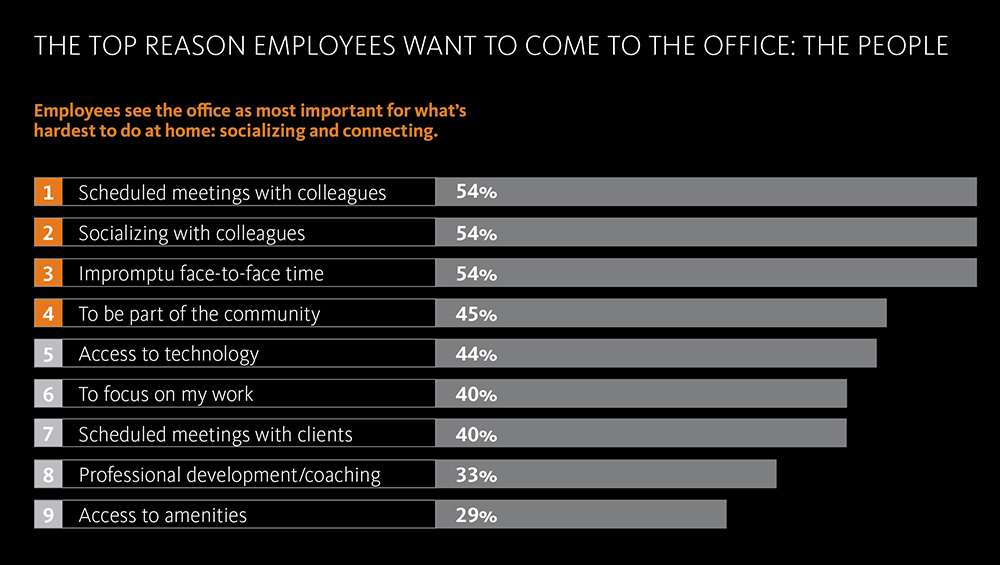Office Workers Want Flexibility in the Future
Reports from Cushman & Wakefield and Gensler found workers would like to keep work-from-home options.
By all accounts, America’s work from home experiment has been successful. Workers have proved they can be productive from their homes, thanks to remote collaboration technology. As cities and states begin to reopen, however, employers are grappling with when and how to bring workers back to their offices and what those spaces will look like.
Two new studies—one by Cushman & Wakefield and another by Gensler—may provide some guidance.
READ ALSO: CRE Could Face Long Road to Recovery: UBS
 Gensler’s U.S. Work from Home Survey 2020, which surveyed more than 2,300 full-time U.S. office workers at companies of 100 or more employees, asked what workers miss most about working from the office and found that three out of four survey respondents said “the people.” The Gensler report states a majority of workers also responded that certain activities like collaborating and staying informed about what others are working on are harder to do at home, “underscoring the value of physical presence.”
Gensler’s U.S. Work from Home Survey 2020, which surveyed more than 2,300 full-time U.S. office workers at companies of 100 or more employees, asked what workers miss most about working from the office and found that three out of four survey respondents said “the people.” The Gensler report states a majority of workers also responded that certain activities like collaborating and staying informed about what others are working on are harder to do at home, “underscoring the value of physical presence.”
The Gensler survey found only 12 percent of U.S. workers want to work from home full time. Seventy percent said they preferred to work in the office for most of the week. About 30 percent want a flexible work arrangement. Many of the respondents said critical changes needed to be made before they feel comfortable returning to offices, in particular, ensuring there is more space for physical distancing and increased cleaning protocols.
Other study findings include: 55 percent said there should be stricter policies against coming to work sick; 50 percent said there should be increased office cleaning; and 35 percent said there should be increased distance between workstations. Some respondents said there should be more private offices (22 percent); more defined private space (21 percent) and no shared workstations (19 percent). Surveyed workers also want fewer face-to-face meetings (23 percent) and physical changes like touchless bathroom fixtures and doors (33 percent). About 31 percent would like air purification systems installed.
“People want to go back to their offices, and the data shows us that a combination of new policies around sick leave and working from home ranks at the top. Those kinds of policy changes are likely to be something that stays around even post-pandemic,” Diane Hoskins, co-CEO of Gensler, told Commercial Property Executive.
Andy Cohen, co-CEO at Gensler, said in the near term they expect to see changes in food-based amenities and services with prepackaged and individual portions offered rather than open selection, until there is a proven level of safety again.
When asked how the coronavirus crisis will impact future designs for shared amenities that have become popular in modern offices, including cafes and lounges, Cohen said those concerns are part of conversations they are having with clients, partners and experts.
“What we know from our research and our clients is that people still want to be together. Amenity and shared spaces do just that. The projects we are designing now will be complete in two to three years from now, which is expected to be a post-COVID world,” Cohen told CPE. “The amenities needed in two to three years will be centered more around health and wellness and sustainability. These were trends we were already seeing and are now being expedited and adopted to more projects, as a result of this crisis.”

Image courtesy of Gensler
Flexibility and Functionality
Cushman & Wakefield’s report, The Future of the Workplace: How will COVID-19 and Data Shape the New Workplace Ecosystem? notes that employers will have a new purpose in the post-pandemic world: providing “inspiring destinations that strengthen cultural connection, learning, bonding with customers and colleagues, and foster creativity and innovation.”
Cushman & Wakefield’s survey found, however, that the majority of employees want flexibility and choice of work locations even after the health crisis is over. The report notes that 73 percent of the workforce surveyed believes their company should embrace some level of long-term or permanent working from home and 50 percent said they will likely be working across a total workplace ecosystem-balancing office, home and third places. For its report, Cushman & Wakefield analyzed responses from more than 40,000 individuals around the globe, representing about 30 companies across nearly 20 industries.
“It’s imperative to recognize that the workplace will no longer be a single location, but an ecosystem of a variety of locations and experiences to support flexibility, functionality and employee well-being,” Brett White, executive chairman & CEO of Cushman & Wakefield, said in a prepared statement.
The Cushman & Wakefield report noted the office won’t disappear entirely, but employers will have to balance the impact of social distancing on density—likely with a staggered workforce to keep office occupancy within safe ranges and to keep public transportation less congested.
“We expect current real estate footprint sizes to remain steady. Flexible working practices may result in fewer people in the office at any one time, but that space saving is offset by the need to accommodate social distancing in the office,” White said.







You must be logged in to post a comment.